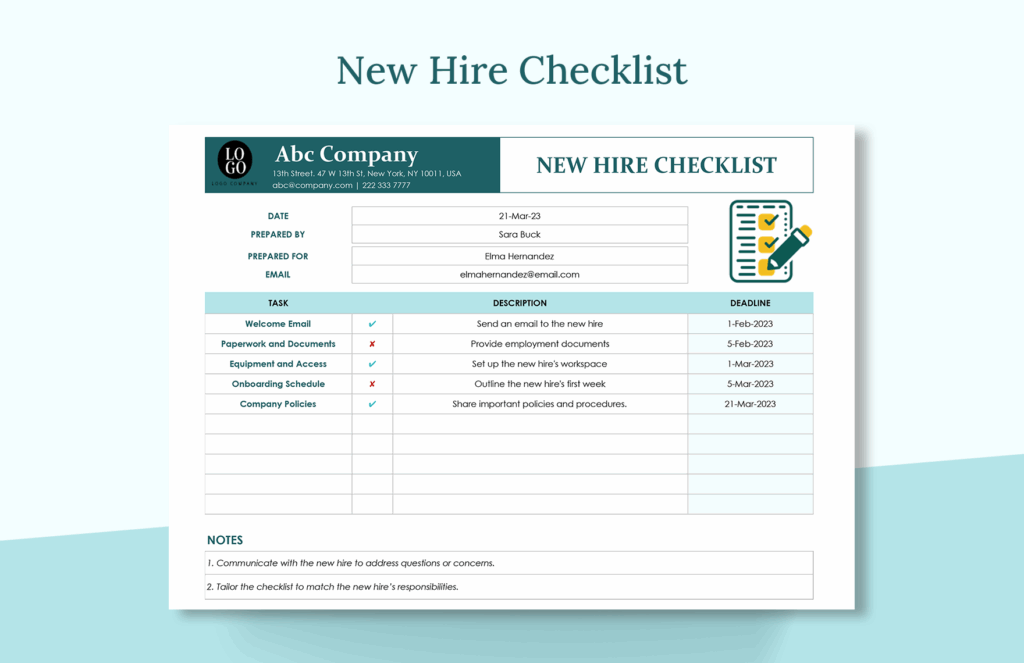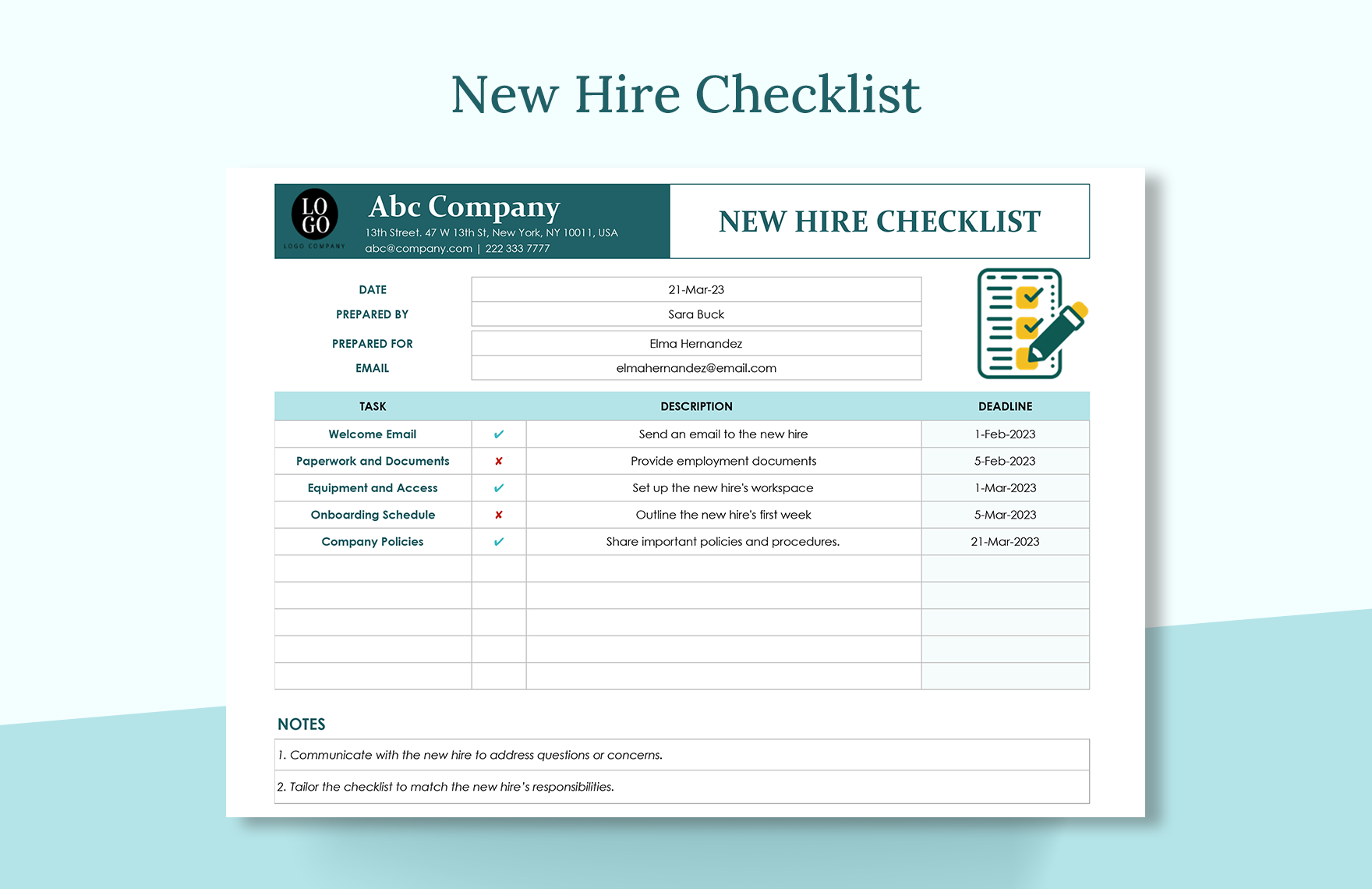
The Ultimate New Hire Document Checklist: Ensuring a Smooth Onboarding Process
Onboarding a new employee is a critical process for any organization. A well-structured onboarding experience sets the stage for a productive and engaged workforce. Central to this process is a comprehensive new hire document checklist. This checklist ensures that all necessary paperwork is completed efficiently and accurately, paving the way for a seamless transition for the new team member. Without a clear new hire document checklist, companies risk compliance issues, delays, and a negative first impression. This guide will outline the essential components of a robust new hire document checklist, providing a framework for HR professionals and hiring managers to streamline their onboarding procedures.
Why a New Hire Document Checklist is Essential
A new hire document checklist is more than just a list of forms; it’s a strategic tool that enhances the onboarding experience and minimizes administrative burdens. Here are some key benefits:
- Compliance: Ensures adherence to federal, state, and local regulations.
- Efficiency: Streamlines the onboarding process, saving time and resources.
- Organization: Provides a structured approach to managing new hire paperwork.
- Positive First Impression: Demonstrates professionalism and attention to detail.
- Data Security: Helps protect sensitive employee information.
By implementing a thorough new hire document checklist, companies can mitigate risks, improve efficiency, and create a welcoming environment for new employees.
Key Components of a Comprehensive New Hire Document Checklist
A well-designed new hire document checklist should include the following essential documents and information. Note that specific requirements may vary based on industry, location, and company size.
Essential Identification and Eligibility Documents
These documents are crucial for verifying the new employee’s identity and legal eligibility to work in the United States.
- Form I-9, Employment Eligibility Verification: Required by the U.S. Citizenship and Immigration Services (USCIS) to verify the identity and employment authorization of individuals hired for employment in the United States. This form must be completed and submitted with supporting documentation, such as a passport or driver’s license and Social Security card.
- Acceptable Documents for Form I-9: A list of documents that new hires can use to prove their identity and employment authorization.
- Social Security Card: While not mandatory for Form I-9, providing a Social Security card is generally required for payroll and tax purposes.
Tax-Related Documents
Accurate tax documentation is essential for proper payroll processing and compliance with tax laws.
- Form W-4, Employee’s Withholding Certificate: Determines the amount of federal income tax to withhold from the employee’s paycheck.
- State Tax Withholding Form: Similar to Form W-4, but specific to the employee’s state of residence.
- Local Tax Withholding Form (if applicable): Some localities require employees to complete a local tax withholding form.
Employment Agreement and Policies
These documents outline the terms and conditions of employment and ensure that the new employee understands company policies.
- Offer Letter: A formal document outlining the terms of employment, including job title, salary, start date, and benefits.
- Employment Agreement: A legally binding contract that details the rights and responsibilities of both the employer and the employee. [See also: Employee Contract Best Practices]
- Non-Disclosure Agreement (NDA): Protects confidential company information.
- Non-Compete Agreement (if applicable): Restricts the employee from working for a competitor for a specified period after leaving the company.
- Employee Handbook: Provides a comprehensive overview of company policies, procedures, and expectations.
- Code of Conduct: Outlines the ethical standards and behaviors expected of all employees.
- Acknowledgement of Policies: A signed statement confirming that the employee has read and understands the company’s policies and procedures.
Benefits Enrollment Forms
These forms allow the new employee to enroll in company-sponsored benefits programs.
- Health Insurance Enrollment Form: Allows the employee to enroll in the company’s health insurance plan.
- Dental Insurance Enrollment Form: Allows the employee to enroll in the company’s dental insurance plan.
- Vision Insurance Enrollment Form: Allows the employee to enroll in the company’s vision insurance plan.
- Life Insurance Enrollment Form: Allows the employee to enroll in the company’s life insurance plan.
- Retirement Plan Enrollment Form (e.g., 401(k)): Allows the employee to enroll in the company’s retirement plan.
- Beneficiary Designation Form: Designates the beneficiary for life insurance and retirement plans.
Direct Deposit Information
This information is needed to set up direct deposit for the employee’s paycheck.
- Bank Account Information: Includes the bank name, account number, and routing number.
- Voided Check or Bank Statement: Used to verify the accuracy of the bank account information.
Emergency Contact Information
This information is crucial in case of an emergency involving the employee.
- Emergency Contact Name: The name of the person to contact in case of an emergency.
- Emergency Contact Phone Number: The phone number of the emergency contact.
- Emergency Contact Relationship: The relationship of the emergency contact to the employee.
Other Important Documents
Depending on the industry and company, additional documents may be required.
- Background Check Authorization Form: Authorizes the company to conduct a background check on the employee.
- Drug Screening Consent Form: Authorizes the company to conduct a drug screening on the employee.
- Confidentiality Agreement: Protects sensitive company information.
- Intellectual Property Agreement: Assigns ownership of intellectual property created by the employee to the company.
- Professional Licenses or Certifications (if applicable): Copies of relevant professional licenses or certifications.
- Prior Employment Verification: Documentation verifying previous employment history.
Creating and Implementing Your New Hire Document Checklist
Developing and implementing an effective new hire document checklist requires careful planning and execution. Here are some best practices:
- Customize the Checklist: Tailor the checklist to your specific industry, company size, and legal requirements.
- Use Digital Tools: Leverage HR software and electronic signature platforms to streamline the document collection process.
- Provide Clear Instructions: Ensure that new hires understand what documents are required and how to complete them.
- Offer Support: Provide assistance to new hires who have questions or need help completing the paperwork.
- Maintain Confidentiality: Protect sensitive employee information by storing documents securely.
- Regularly Update the Checklist: Keep the checklist up-to-date with changes in laws and regulations.
- Automate Where Possible: Integrate the new hire document checklist into your HRIS system to automate reminders and track progress.
Leveraging Technology for a Streamlined Onboarding Process
Technology plays a crucial role in modernizing the onboarding process and enhancing the efficiency of the new hire document checklist. Here are some ways to leverage technology:
- HR Software: Use HR software to manage the entire onboarding process, from document collection to task assignment.
- Electronic Signature Platforms: Allow new hires to sign documents electronically, eliminating the need for paper-based forms.
- Document Management Systems: Store and organize new hire documents securely in a centralized location.
- Onboarding Portals: Provide new hires with a dedicated portal where they can access required documents and complete onboarding tasks.
- Automated Reminders: Set up automated reminders to ensure that new hires complete their paperwork on time.
Common Mistakes to Avoid
While a new hire document checklist is essential, it’s important to avoid common mistakes that can undermine its effectiveness:
- Using an Outdated Checklist: Ensure that the checklist is up-to-date with current laws and regulations.
- Failing to Provide Clear Instructions: Provide clear and concise instructions for completing each document.
- Neglecting Data Security: Protect sensitive employee information from unauthorized access.
- Overwhelming New Hires: Break down the onboarding process into manageable steps to avoid overwhelming new hires.
- Ignoring Feedback: Solicit feedback from new hires on the onboarding process and use it to make improvements.
The Future of New Hire Onboarding
The future of new hire onboarding is likely to be increasingly digital and personalized. Companies will continue to leverage technology to streamline the onboarding process and create a more engaging experience for new hires. [See also: Trends in Employee Onboarding] This includes using artificial intelligence (AI) to personalize the onboarding experience, gamification to make the process more engaging, and virtual reality (VR) to provide immersive training experiences.
Conclusion
A well-structured new hire document checklist is a cornerstone of a successful onboarding process. By ensuring that all necessary paperwork is completed efficiently and accurately, companies can create a positive first impression, minimize compliance risks, and set the stage for a productive and engaged workforce. Embracing technology and best practices will further enhance the effectiveness of the new hire document checklist, leading to a more seamless and rewarding onboarding experience for both the new employee and the organization. Taking the time to create and maintain a comprehensive new hire document checklist will pay dividends in the long run, contributing to a more efficient and compliant HR department and a happier, more productive workforce. The implementation of a new hire document checklist is not just a procedural requirement; it is an investment in the future success of your organization. Remember to regularly review and update your new hire document checklist to ensure it remains compliant and effective. A robust new hire document checklist demonstrates a commitment to professionalism and organization, setting a positive tone for the employee’s journey with the company. Therefore, a well-executed new hire document checklist is an invaluable asset for any organization seeking to optimize its onboarding process and foster a thriving workplace culture. Don’t underestimate the power of a meticulously crafted new hire document checklist; it’s the foundation upon which successful employee integration is built. By focusing on the details of the new hire document checklist, companies can ensure a smooth and compliant start for every new team member.

